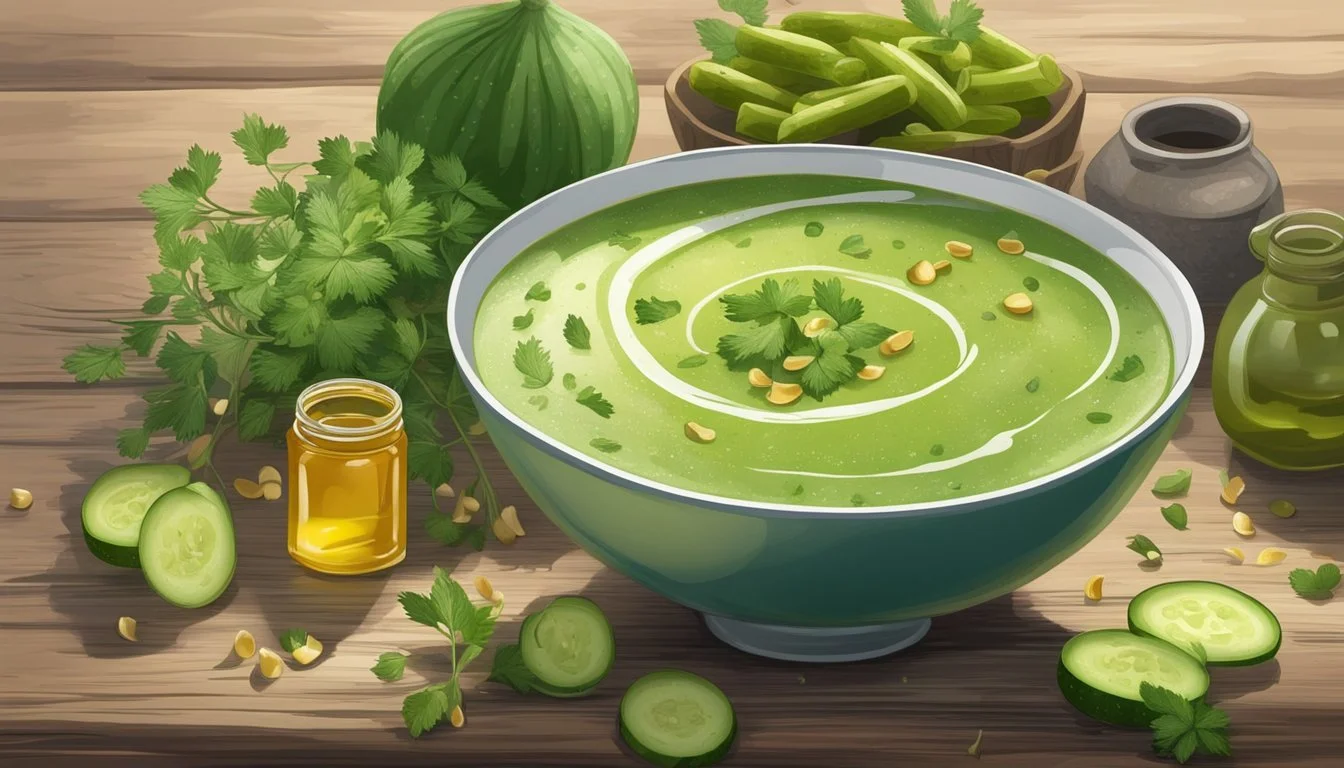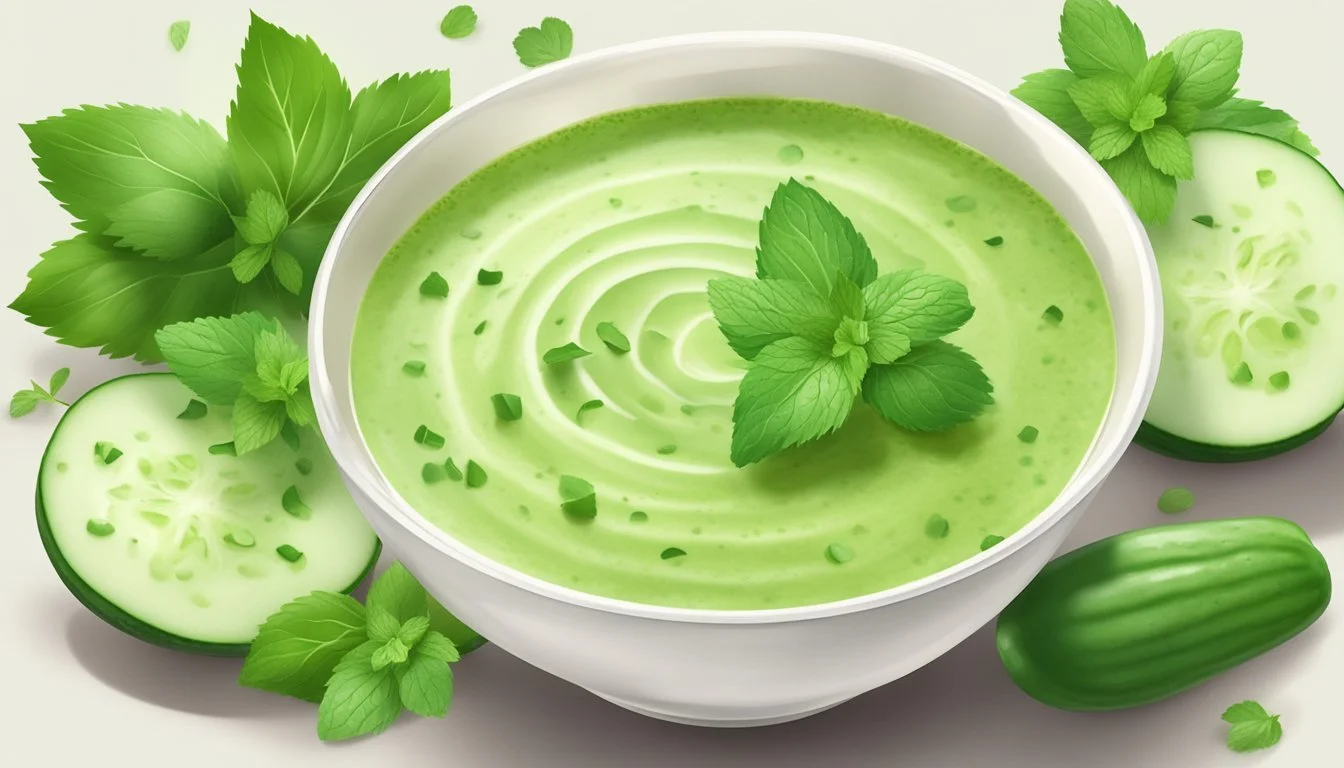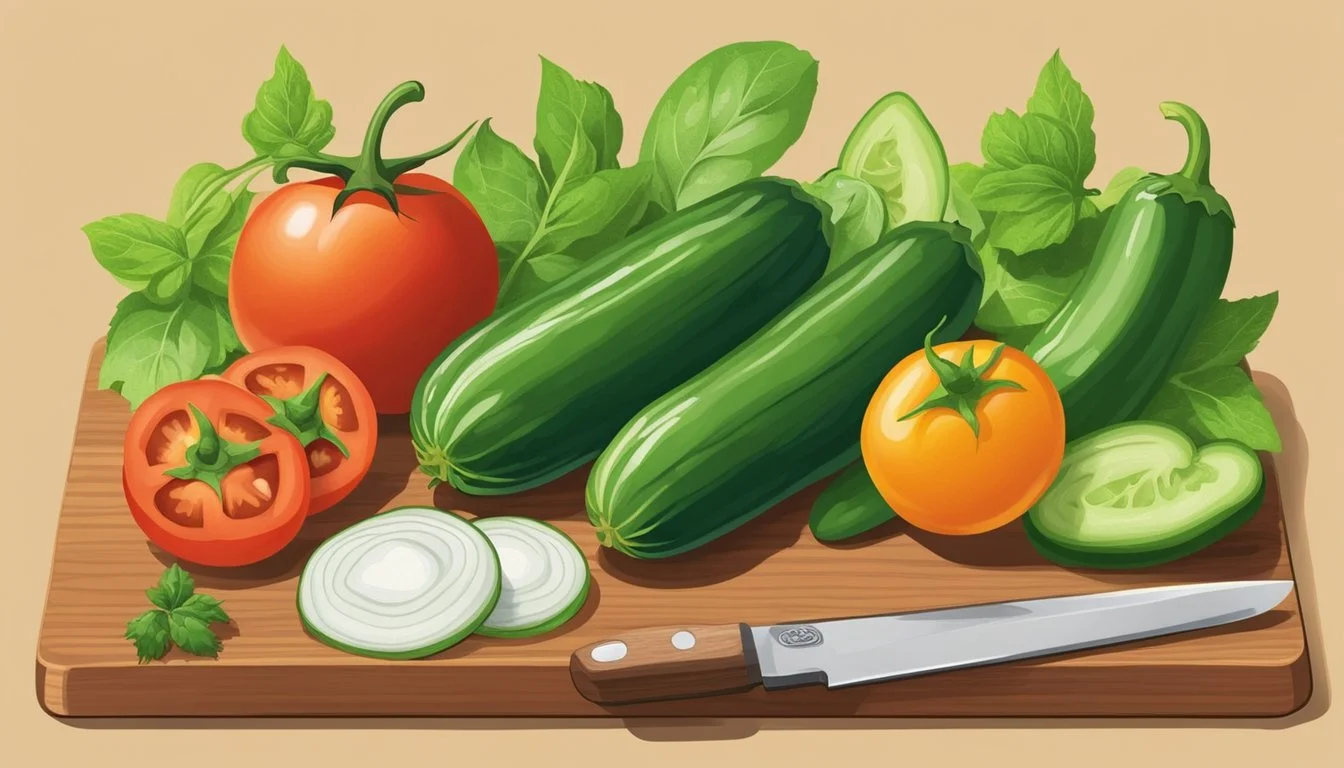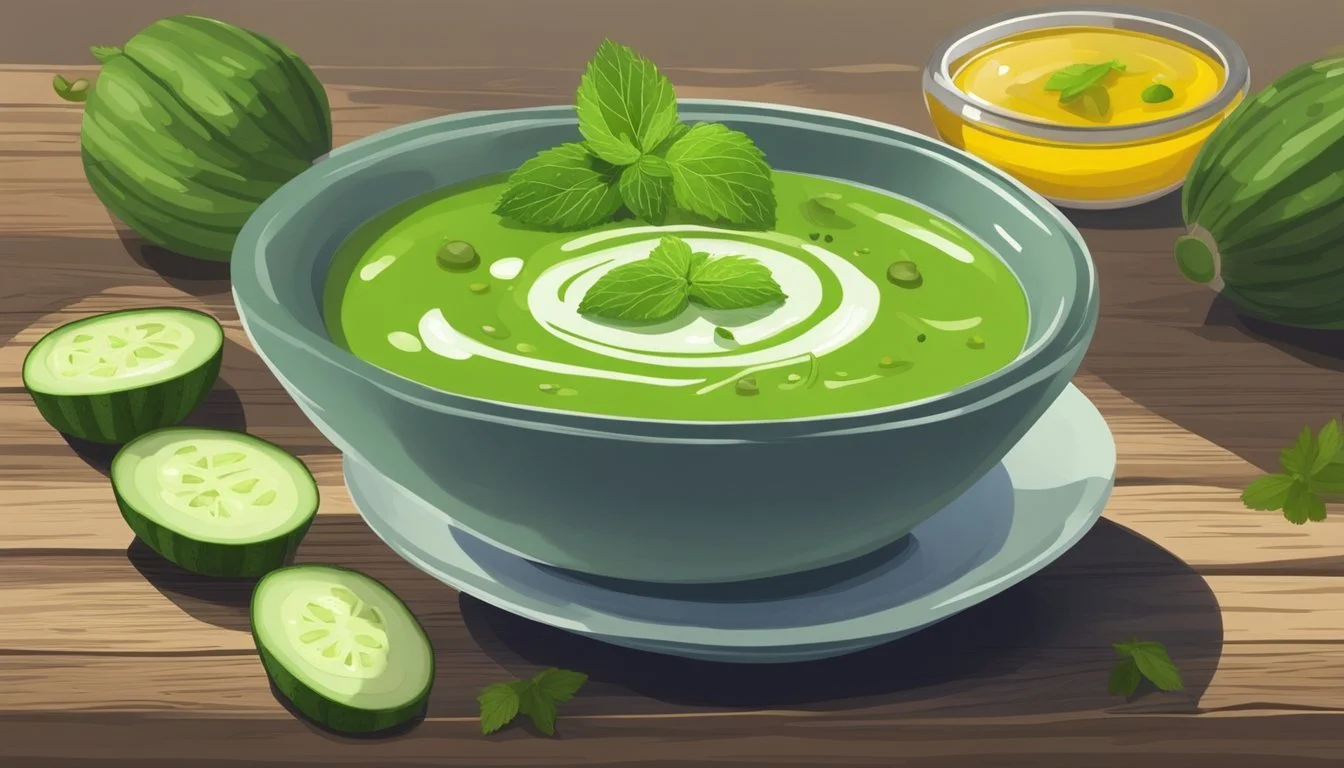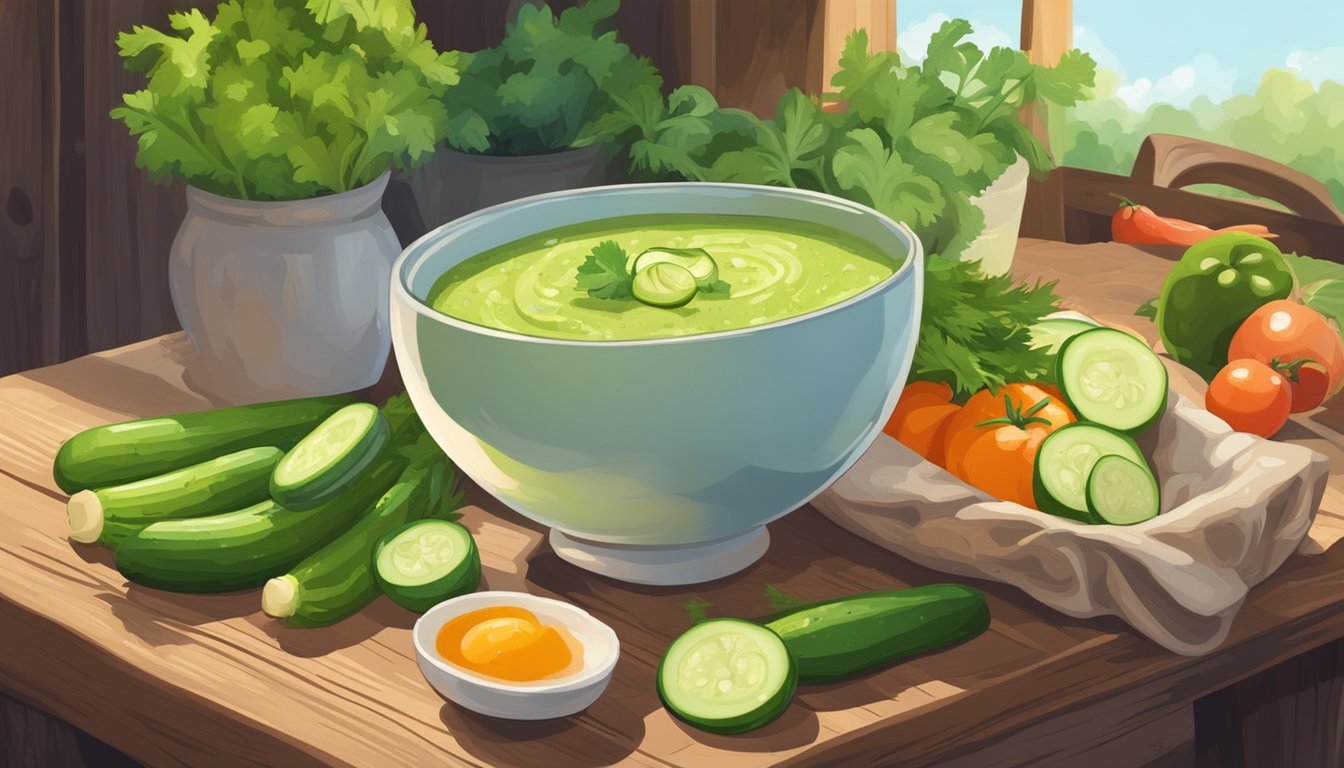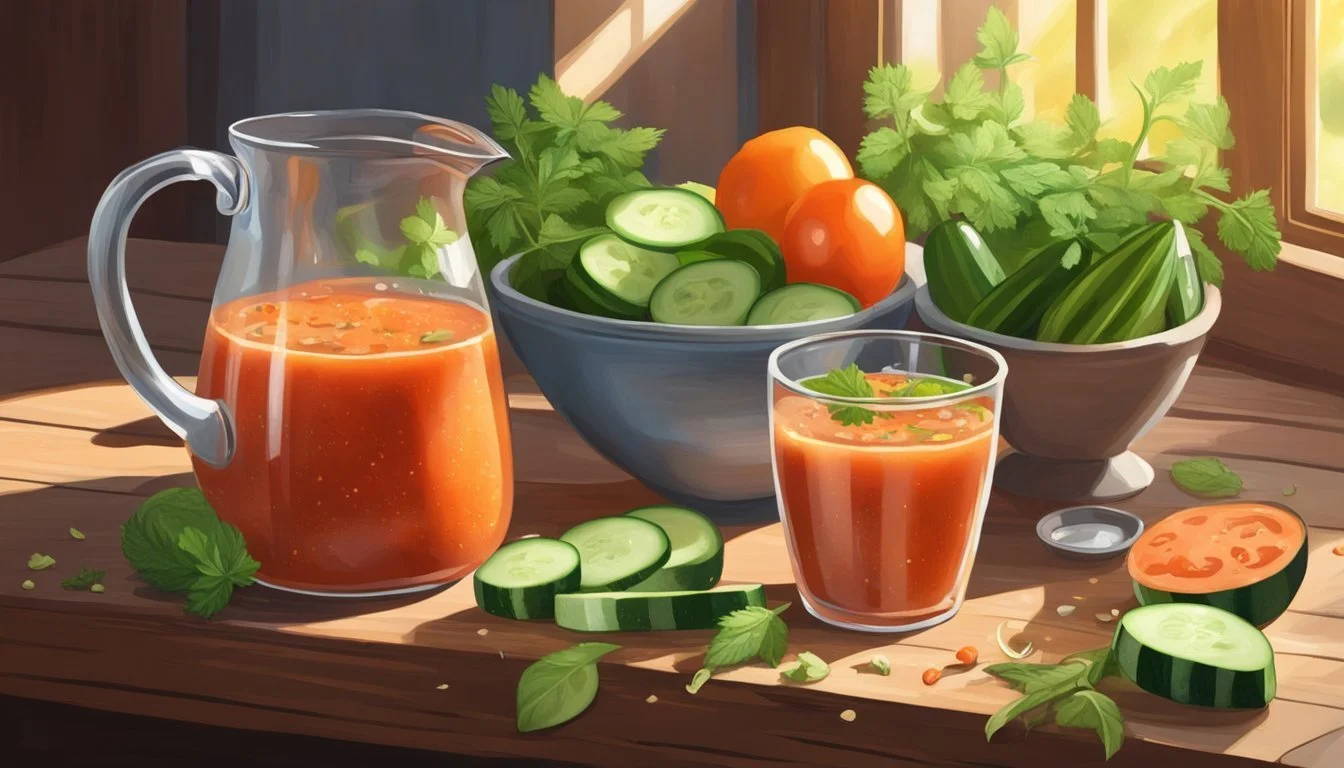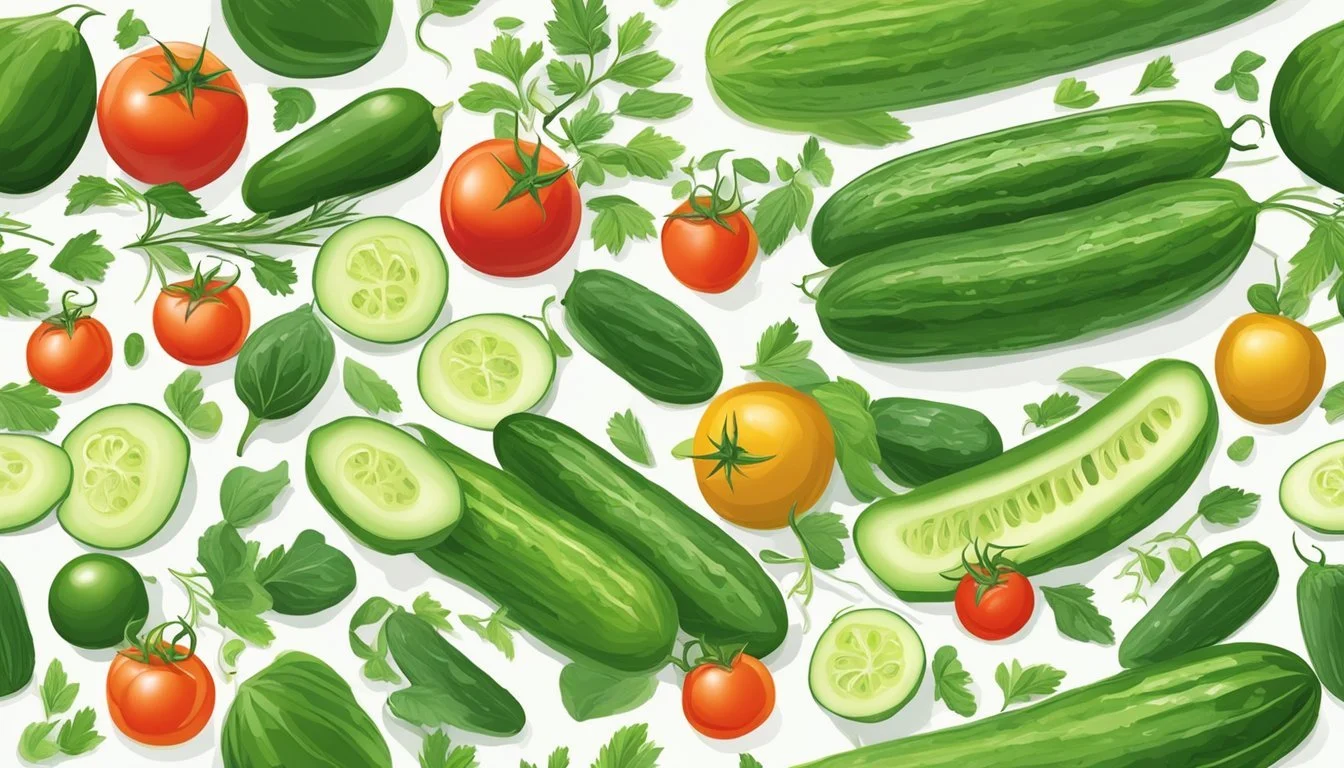Cucumber Peel Gazpacho
The Ultimate Recipe for a Cool Summer Delight
Cucumber Gazpacho offers a refreshing twist on the classic Spanish soup, perfect for summer dining. Unlike the traditional tomato-based variant, this version spotlights the cool crispness of cucumbers, making it an excellent choice for warm weather refreshment. Incorporating the entirety of the vegetable, peel included, not only maximizes flavor but also nutritional benefit, as cucumber peels are rich in fiber and vitamins.
The essence of gazpacho lies in its chilled serving temperature, which enhances the soup's ability to cool down its consumers during the hot months. By blending fresh cucumbers with a selection of herbs, spices, and sometimes a tangy component like yogurt or sour cream, the dish achieves a balance that is both satisfying and light. The preparation of this soup is straightforward and adaptable, allowing for the use of a variety of garnishes to suit different palates.
Serving Cucumber Peel Gazpacho can elevate a summer meal, be it as a starter or a main dish. The gazpacho's striking green color and delicate taste invite a creative presentation with colorful garnishes such as diced vegetables, herbs, or edible flowers. Its versatility extends beyond mere aesthetics; the soup can be tailored to accommodate dietary preferences and is often appreciated for its healthful properties.
The Origin and Popularity of Gazpacho
Gazpacho originated in the southern region of Spain, a country known for its rich culinary traditions. This cold soup, traditional to Andalusia, has a history that spans centuries. While cold soups (What wine goes well with soups?) date back to Roman times, gazpacho, as it is recognized today, has its roots firmly established in Spanish cuisine.
The original gazpacho was a humble mixture, created out of necessity using what was readily available. Early recipes included a simple blend of bread crumbs, garlic, olive oil, vinegar, salt, and water. The versatility and utility of this dish made it a staple, particularly relevant during the hot summer months as an accessible and cooling meal.
As tomatoes were introduced to Europe in the 16th century, they became an essential ingredient in what is now known as gazpacho. Over time, the addition of other fresh vegetables like cucumbers and bell peppers (What wine goes well with bell peppers?) enhanced its flavor profile. Today, gazpacho is savored for its vibrant freshness and is often regarded as the quintessential summer soup.
The popularity of gazpacho has transcended Spanish borders, garnering global recognition. It stands as a healthy, refreshing option enjoyed in various iterations, adapting to regional tastes and seasonal ingredients. In Spain, gazpacho continues to be a cultural emblem, celebrated for its simplicity and connection to the agricultural heartbeat of the country.
Gazpacho is more than a dish; it is a cherished representation of Spanish heritage, enjoyed by people all over the world who appreciate its cool, revitalizing qualities during the warmer seasons.
Selecting Quality Ingredients
For a refreshing and flavorful Cucumber Peel Gazpacho, it is imperative to start with the freshest and highest quality ingredients. These form the foundation of the soup's vibrant taste and appealing texture.
Choosing the Best Cucumbers
Cucumbers are the heart of gazpacho, and their quality directly impacts the soup's characteristic freshness. For the crispest texture, one should opt for firm, bright green cucumbers with no spots or blemishes. The skin should be intact and not waxed, as it will be included in this peel-on recipe for additional nutrients.
Tomato Varieties for Gazpacho
Tomatoes add depth and a slight acidity to the gazpacho, balancing the coolness of the cucumbers. Roma or vine-ripened tomatoes are ideal for their dense, meaty texture and concentrated flavor. They should feel heavy for their size, indicating juiciness, and the skin should give slightly when pressed.
Herbs and Spices for Flavor
Herbs and spices are the subtle touches that can elevate the gazpacho from simple to sublime. Fresh is best when it comes to herbs like basil, mint, and cilantro; they should look vibrant and smell aromatic. For the best flavor fusion, freshly cracked black pepper and a pinch of salt are essentials. Finely minced garlic enhances the complexity, and high-quality extra virgin olive oil rounds out the flavors with its fruity notes and smooth finish.
Nutritional Benefits of Cucumber Gazpacho
Cucumber gazpacho is a vibrant, chilled soup that boasts an array of nutritional advantages. Primarily composed of cucumbers, this dish is inherently low in calories, making it an ideal option for individuals monitoring their calorie intake. Cucumbers are replete with water, which aids in hydration and fullness without adding a significant caloric load.
Beyond cucumbers, gazpacho typically includes a mix of vegetables and fruits, such as tomatoes, peppers, and onions. Vegetables and fruits contribute essential vitamins and minerals to the dish. For instance, tomatoes offer lycopene and vitamin C, while peppers are a source of beta-carotene and additional vitamin C.
Olive oil, another key component, is revered for its heart-healthy monounsaturated fats. These fats are beneficial for cardiovascular health and can help to manage cholesterol levels. Olive oil also carries phenolic compounds that have antioxidant properties.
Nutrient Benefit Water Content Supports hydration and may reduce overall calorie intake. Vitamins & Minerals Essential for various bodily functions and overall health. Healthy Fats Monounsaturated fats contribute to cardiovascular wellbeing.
The cuisine is notably healthy because it encourages the consumption of a high volume of vegetables and fruits with every serving. This aspect is aligned with dietary guidelines that advise a focus on plant-based foods for improved health outcomes. Moreover, the soup's nutrients are typically preserved due to the minimal processing involved, which entails blending the ingredients raw, thus maintaining their nutritional integrity.
Preparing the Vegetables
The preparation of vegetables is crucial to the essence of cucumber peel gazpacho. It ensures a uniformly smooth texture and a pure, vibrant flavor profile, setting the stage for a refreshing summer soup.
Washing and Peeling Produce
When beginning to prepare the cucumber peel gazpacho, washing the vegetables is an essential first step. It is important to thoroughly rinse cucumbers, tomatoes, and onions under cold water to remove any lingering dirt or residues. Cucumbers, being the star component, often have a waxy coating if not organic, and need to be peeled to contribute to the soup's smooth consistency.
Vegetable Preparation Cucumbers Peel, then dice Tomatoes Core, then chop Onions Peel, then finely dice
Peeling cucumbers can also be a strategic choice for aesthetic purposes, as it can lighten the color of the gazpacho. Peel tomatoes if preferred, especially if the skin is tough, to ensure no coarse textures detract from the enjoyment.
The Importance of Freshness
Freshness in ingredients is paramount. The vegetables should be ripe, but firm to the touch – this signifies they are at peak freshness, which translates to more intense and lively flavors in the gazpacho. Fresh herbs such as basil or parsley should be aromatic and brightly colored, without any discolored spots. They accentuate the flavor of the vegetables, providing depth and freshness to the dish. Use herbs to garnish just before serving to retain their robust flavor and visual appeal.
Gazpacho Recipe Variations
Exploring variations of gazpacho recipes allows for personalization and adaptation to one’s taste preferences or dietary needs. These can range from the classic cucumber gazpacho to incorporating novel ingredients for a unique twist.
Classic Cucumber Gazpacho
For a Classic Cucumber Gazpacho, the foundational recipe consists of cucumbers, green bell peppers, and onions pureed with extra virgin olive oil, vinegar, and garlic. To this, they typically add lime juice for a tangy zing and Greek yogurt for creaminess. Here's a simple list:
Cucumbers: Peeled and chopped
Green Bell Peppers: Seeded and chopped
Onions: Chopped
Extra Virgin Olive Oil: For a smooth texture
Vinegar: Typically sherry or red wine vinegar for acidity
Garlic: Minced
Lime Juice: Freshly squeezed
Greek Yogurt: Optional, for creaminess
Creative Additions and Substitutes
Those seeking to get creative can add or substitute ingredients for an innovative take on gazpacho. Adding avocado gives gazpacho a richer, creamier texture, while watermelon can introduce a sweet note to the classic savory profile. For a more substantial dish, they can top the soup with grilled shrimp (What wine goes well with shrimp?) or sprinkle with toasted slivered almonds. Some substitutes include:
Avocado: Blend in with the base for richness.
Watermelon: Chop and blend with cucumbers for sweetness.
Shrimp: Grilled or cooked, as a topping for protein.
Almonds: Toasted, as a garnish for a nutty crunch.
Each of these ingredients can be adjusted to taste, and individuals may experiment with the quantity to achieve their preferred balance of flavors.
Blending for the Perfect Texture
When crafting a cucumber gazpacho that's both refreshing and satiating, the texture is key. Blending techniques can affect whether the soup is luxuriously creamy or pleasingly chunky, and even influence the need for dairy additions.
Achieving Creaminess without Dairy
To obtain a creamy texture without dairy, one should utilize a high-speed blender. This kitchen tool can puree cucumber and other ingredients to a velvety smoothness that mimics the richness typically provided by cream or yogurt. Moreover, for a vegan option, ingredients such as soaked cashews or silken tofu can replace dairy, emulsifying within the soup to add body and smoothness without altering the fresh cucumber flavor.
Example:
Soaked cashews: blend until completely smooth
Silken tofu: add in small increments to avoid thinning the soup too much
Adjusting for Consistency
To adjust the soup to one's preferred consistency, gradually add water while blending. This allows the chef to tailor the gazpacho's thickness precisely. For those who desire some texture, blending can be halted before the mixture becomes entirely smooth, or small pieces of chopped cucumber can be reserved and stirred in afterwards. If the gazpacho becomes too thin, one traditional method to thicken it is by incorporating bread that has been soaked in water or vinegar.
Tips:
Start with less liquid: Add more to thin out if needed
Use soaked bread for thickening: Blend until it's fully integrated and no clumps remain
Seasoning and Balancing Flavors
The mastery of cucumber gazpacho lies in achieving a harmonious balance between tanginess, sweetness, and seasoning. A critical step is tasting as you go to adjust the flavors according to your preferences.
Salt and pepper serve as foundational elements, bringing out the natural flavors of the cucumber. Start with a pinch of salt, taste, and add more as needed. Black pepper can be added sparingly for a subtle bite.
Citrus plays a pivotal role; both lime and lemon juice add a vibrant zestiness to the gazpacho. Lime juice contributes a sweet tang, while lemon offers a sharper tartness. Depending on the desired outcome, one may opt for the sweetness of lime or the brisk flavor of lemon.
Citrus Type Flavor Characteristic Lime Sweet and tangy Lemon Sharp and acidic
To finesse the flavors, garnishes can impart both aesthetic appeal and additional layers of taste. Consider sprinkling chopped herbs or adding a dollop of seasoned sour cream. The herbaceous brightness or the creamy tang can counterbalance the soup’s inherent sweetness.
In summary, the alchemy of seasoning in cucumber gazpacho involves subtle tweaks. With judicious use of salt, pepper, and citrus juices, and creative garnish choices, one can achieve a soup that sings with freshness and flavor.
The Art of Chilling Gazpacho
Proper chilling is crucial for serving gazpacho, amplifying its flavors and providing a refreshing experience on hot summer days.
Refrigeration Time
For gazpacho to reach its full potential, it must be allowed to chill in the fridge for an adequate amount of time. This process allows the flavors to meld and the soup to become thoroughly cold. Typically, a minimum of 1-2 hours is recommended, but for optimal results, chilling overnight is ideal.
Minimum Time: 1-2 hours
Optimal Time: Overnight (approx. 8 hours)
Serving Gazpacho Cold
When serving, it is essential to maintain the cold temperature of gazpacho to provide that burst of coolness desired during summer. One should serve the soup in chilled bowls or cups to ensure it stays cold for longer. Additionally, if the gazpacho is to be served immediately and hasn't been refrigerated for a long time, adding a few ice cubes can help drop the temperature rapidly.
Use chilled serving bowls: Store bowls in the fridge prior to serving.
Add ice cubes if needed: Only if the soup hasn't been chilled for long enough.
Garnishing and Serving Suggestions
Proper garnish not only enhances the flavor of Cucumber Peel Gazpacho but also adds a visual appeal that can elevate the overall dining experience. Here, we explore both traditional and contemporary garnishes that complement this refreshing summer soup.
Traditional Garnishes
For a classic approach, the Cucumber Peel Gazpacho benefits from a combination of finely chopped vegetables and a drizzle of high-quality olive oil. They traditionally include:
Cucumber slices: A few thin slices add a refreshing crunch.
Peppers: Diced red or green peppers contribute a mild zest.
Red onion: Chopped red onion offers a sharp bite that contrasts well with the cool soup.
Chives: Snipped fresh chives deliver an oniony flavor that is both subtle and sharp.
Innovative Toppings for a Modern Twist
The modern culinary scene encourages experimentation. Here are some innovative toppings that can infuse a contemporary twist into the classic Gazpacho:
Pine nuts: Toasted pine nuts provide a buttery texture and a nutty taste.
Edible flowers: Petals from edible flowers can turn a simple bowl of soup into a work of art.
Croutons: Golden, crunchy croutons offer a satisfying textural contrast.
Zucchini Ribbons: Thinly sliced zucchini ribbons can introduce a tender yet firm element to the dish.
When serving, ensure that the soup is well chilled and consider the balance of flavors and textures that each garnish will bring to the Gazpacho for a perfect summer refreshment.
Pairing Gazpacho with Other Dishes
When serving cucumber peel gazpacho, the key is choosing accompaniments that complement its cool and refreshing profile. This chilled soup often sets the stage for a light and vibrant meal, making it a superb option for a summer luncheon or dinner starter.
Appetizers: Gazpacho pairs beautifully with light appetizers such as a simple melon and prosciutto or a seafood selection like shrimp cocktail. (What wine goes well with shrimp cocktail?) Its crispness cleanses the palate, preparing diners for the following courses.
Melon and Prosciutto
Shrimp Cocktail
Side Dishes: To maintain the meal's refreshing theme, side dishes should be equally light. A salad dressed with a citrusy vinaigrette or an assortment of grilled vegetables (What wine goes well with grilled vegetables?) can add a delightful contrast in both texture and temperature.
Citrus Salad
Grilled Vegetables
Salad: A green salad with crisp ingredients such as arugula, spinach, and romaine lets the fresh flavors shine alongside the gazpacho. It's best to choose a dressing that is not too overpowering, to keep the flavors balanced.
Arugula and Spinach
Romaine
Crusty Bread: No gazpacho meal is complete without a serving of crusty bread on the side. It provides a satisfying crunch and a way to savor every last drop of the soup. Opt for a baguette or artisanal sourdough to dip into the gazpacho, adding a heartier element to the meal.
Baguette
Sourdough Bread
In summary, cucumber peel gazpacho can be harmoniously matched with a variety of dishes that share its fresh and light characteristics, making for a well-rounded and enjoyable dining experience.
Special Dietary Considerations
When preparing Cucumber Peel Gazpacho, it is pivotal to consider the dietary needs and restrictions of those who will enjoy the dish. This section addresses how to adapt the recipe for vegan consumers and provides guidance for a gluten-free and allergy-friendly variation.
Making Vegan Cucumber Gazpacho
Cucumber Gazpacho can easily be made vegan by substituting animal-derived ingredients with plant-based alternatives. Classic gazpacho often includes Greek yogurt or sour cream to provide creaminess. A vegan version can achieve a similar texture by using the following vegan substitutes:
Sour Cream Alternatives:
Soy-based sour cream
Coconut cream (thinned with a tablespoon of water if necessary)
Yogurt Alternatives:
Soy yogurt
Almond milk yogurt
Coconut milk yogurt
To enhance the flavor, chefs should ensure that any additional garnishes such as edible flowers or chopped vegetables are also vegan friendly.
Gluten-Free and Allergy-Friendly Options
For individuals with gluten sensitivities or allergies, Cucumber Gazpacho is a naturally gluten-free dish as long as all the ingredients are checked for hidden gluten. Here is a checklist to help maintain a gluten-free and allergy-friendly environment:
Broth/Stock: If used, verify it is labeled gluten-free.
Garnishes: Verify that toppings like microgreens or herbs are not cross-contaminated with allergens.
Utensils and Appliances: Use separate or thoroughly cleaned blenders and cutting boards to prevent cross-contamination.
By adhering to these guidelines and carefully selecting ingredients, Cucumber Gazpacho can be a refreshing and inclusive dish for individuals following vegan and gluten-free diets, as well as for those with specific food allergies.
Tips for Storing Leftover Gazpacho
When it comes to preserving the freshness of leftover gazpacho, the fridge is one's best ally. It's crucial to store the soup in an airtight container to maintain its flavor and prevent any unwanted fridge odors from seeping in. They should consume the refrigerated gazpacho within two days for the best quality.
Cool Down: Ensure the gazpacho is at room temperature before storing to prevent condensation inside the container which can water down the soup.
Airtight Containers: Transfer the gazpacho into airtight containers. If they're using bowls, cover them tightly with plastic wrap.
Portioning: If they have a large batch, consider portioning the leftovers into smaller containers. This way, they only open what they'll eat, keeping the rest sealed and fresh.
Labeling: It's helpful to label the container with the storage date, so they'll know to consume it while it's still fresh.
When it comes to freezing, gazpacho’s texture may change due to the high water content in cucumbers. If they choose to freeze, they should thaw it slowly in the fridge and consume it promptly. However, fresh consumption is generally recommended for a refreshing experience.
Quick Tip: Refresh the chilled gazpacho by giving it a good stir before serving, as separation may occur.
Boosting Your Gazpacho with Proteins and Grains
Enhancing a cucumber peel gazpacho extends far beyond mere flavor; it's about transforming the soup into a balanced meal. Incorporating proteins like shrimp and adding grains such as quinoa or corn not only increases nutritional value but also adds a pleasant textural contrast.
Incorporating Seafood
Shrimp is a popular choice for boosting protein in gazpacho. One can incorporate shrimp by either blending them directly into the soup for a smoother consistency or by using them as a garnish for added visual appeal and a burst of flavor. The key lies in the preparation – lightly poaching the shrimp before adding them ensures they retain their delicate texture and sweet taste.
Adding Grains for Texture
Grains offer a unique way to introduce texture into cucumber gazpacho. For a delightful crunch, corn can be either blended for a subtle sweetness or sprinkled on top as a garnish. On the other hand, quinoa provides a healthful twist, adding a satisfying bite and protein boost. Here are some options:
Croutons: Add homemade or store-bought croutons for a classic crunchy element.
Quinoa: Mix in cooked quinoa after blending the gazpacho to maintain its texture.
Grain Preparation Suggestion Potential Benefit Croutons Toss on top before serving Adds crunch Corn Blend for sweetness or garnish Sweetness and crunch Quinoa Stir into finished soup Protein boost and hearty texture
When one selects grains, considering the overall rating of textures in the dish can aid in achieving a harmonious balance. A thoughtful approach to combining these elements results in a cucumber peel gazpacho that is not only refreshing and delicious but also nutritious and satisfying.
Maximizing Flavor the Next Day
When it comes to summer soups like Cucumber Peel Gazpacho, the flavors can deepen remarkably after a night in the fridge. Here are several tips to ensure that one's leftover gazpacho is even more refreshing and flavorful the next day.
Store Properly: Transfer the gazpacho to an airtight container before placing it in the fridge. This prevents the absorption of other flavors and maintains freshness.
Chill Time: Allowing the gazpacho to sit overnight not only cools the soup but lets the ingredients meld. The chilling process is crucial, as it brings out the soup's vibrant, refreshing qualities.
Season Before Serving: Soup's taste can change slightly after being refrigerated. One may need to adjust the seasoning the next day, tasting and adding salt or acid (like vinegar or lemon juice) as necessary to enhance the gazpacho's flavor profile.
Garnish Wisely: While the gazpacho itself benefits from overnight refrigeration, garnishes should be added fresh. They provide a textural contrast and a punch of flavor. Sliced cucumber, chopped herbs, or a swirl of yogurt can elevate the dish.
Table: Ideal Garnishes for Next-Day Gazpacho
Fresh Herbs Textural Add-Ins Creamy Elements Basil Diced cucumber Yogurt Cilantro Chopped bell peppers Sour cream Chives Finely diced shallots Olive oil drizzle
By following these simple steps, one ensures that their gazpacho remains a refreshing and delightful choice for summer meals, offering a blend of heightened tastes that have developed beautifully overnight.
Scaling the Recipe for Events and Gatherings
When preparing cucumber gazpacho for events and gatherings, one needs to consider the number of attendees to ensure that there is a sufficient quantity of this refreshing summer soup. Here's how to efficiently scale the recipe:
Calculate the Quantity: Estimate that each guest will have about one cup as a side dish. For a larger serving size, as a main, they may have up to two cups.
Ingredients Proportion: Increase the ingredients proportionally. The primary ingredient, English cucumbers, should be multiplied by the number of intended servings. Keep a consistent ratio for a balanced flavor.
Preparation in Batches: If the blender capacity is exceeded, prepare the gazpacho in multiple batches. Ensure that each batch is consistent in taste by measuring ingredients carefully.
Serving Size Table:
Attendees 1 Cup Serving (Side Dish) 2 Cups Serving (Main) 10 10 cups 20 cups 50 50 cups 100 cups 100 100 cups 200 cups
Advance Preparation: Gazpacho's flavor develops as it chills, making it ideal for preparation ahead of time. Refrigerate the soup in large sealed containers and stir well before serving.
Garnishes: Offer a variety of garnishes like diced cucumbers, herbs, and edible flowers to allow guests to customize their bowl of gazpacho.
One should ensure the soup remains well-chilled, particularly for outdoor events. Large insulated containers or ice baths can be used to maintain a cool temperature. This cucumber-based soup serves as a versatile recipe, easily adaptable, that can act as a pleasing starter or a light main course for any summertime event.
Health and Wellness Perspectives
Cucumber Peel Gazpacho is not only a healthy choice but also perfectly aligns with the nutritional demands of summer days. This cold soup offers low-calorie refreshment while contributing to hydration and heart-health.
Low-Calorie and Heart-Healthy Profiles
Cucumbers are low in calories, making gazpacho an excellent choice for anyone monitoring their calorie intake. Cucumber Peel Gazpacho is rich in fiber and contains heart-healthy antioxidants. It is typically prepared without high-calorie ingredients, ensuring that it supports a heart-healthy diet.
Calories: Gazpacho provides a filling option with fewer calories.
Antioxidants: Presence of antioxidants supports cardiovascular health.
Fiber: Abundant dietary fiber aids in digestion and maintains heart health.
Hydration and Cooling Effects
During the hotter months, staying hydrated is crucial, and Cucumber Peel Gazpacho serves as an appetizing way to keep fluid levels topped up. Its high water content, coming from cucumbers, delivers a cooling effect, which is both refreshing and beneficial for overall hydration on warm summer days.
Water Content: Cucumbers are composed of about 95% water.
Refreshing: The natural cooling properties of cucumbers make gazpacho refreshing.
Ideal for Summer: Its cold temperature and hydration qualities make it suitable for summer consumption.
Cultural Significance and Variations Globally
Gazpacho is a culturally significant dish originating from Spain. Originally a no-cook recipe, it is often enjoyed in the Spanish regions during the summer for its refreshing qualities. Gazpacho is deeply intertwined with the cultural heritage, representing Spanish cuisine's bright flavors and regional produce.
Globally, variations of gazpacho have proliferated, often taking on local flavors and ingredients. The traditional recipe includes ripe tomatoes, cucumbers, bell peppers, garlic, olive oil, and vinegar. This chilled soup honors the no-cook tradition, making it a cherished dish during hot weather for its cooling effect.
Cucumber Gazpacho emerges as a creative deviation from the classic red gazpacho. Cucumbers replace tomatoes, lending a unique, crisp flavor and texture. This variation underlines gazpacho's versatility across cultures, accommodating diverse palates and seasonal ingredients.
Table of Global Variations:
Country Variation Distinctive Ingredient Portugal Gazpacho Alentejano Bread crumbs Mexico Gazpacho Moreliano Fresh Fruit Italy Gazpacho Bianco Almonds, Grapes
In each case, one can observe the respect for the fundamental aspects of gazpacho – its cold serving temperature and the celebration of fresh produce. The adaptations reflect local tastes and ingredients availability, reinforcing gazpacho's status as a versatile and globally embraced dish.
The culture of gazpacho speaks to the no-cook methodology, a vital element retained in variations worldwide. Its Spanish origin story continues to evolve, as chefs and home cooks alike craft new versions of this quintessential summer soup.
The Role of Gazpacho in Modern Cuisine
Gazpacho has undergone a renaissance in modern cuisine, emerging as an innovative and trendy dish that chefs often use to showcase their culinary creativity. Originally hailing from the sunny climes of Spain, this chilled soup perfectly encapsulates the ethos of contemporary dining with its emphasis on fresh, high-quality ingredients and vibrant flavors.
In the context of modern gastronomy, chefs frequently revisit traditional recipes to offer a new twist, and gazpacho serves as an ideal canvas for this experimentation. While the classic version is a tomato-based vegetable soup, modern renditions might include diverse ingredients such as fruits, unconventional vegetables like cucumbers, or even incorporate rich creams to alter the texture.
Innovative Variations:
Cucumber Peel: Adds a refreshing note and a hint of pleasant bitterness.
Fruit Infusions: Enhance the natural sweetness and add a vibrant color palette.
Herb Enhancements: Such as mint or basil to introduce unique aromatic profiles.
Modern gazpacho aligns with the demand for lighter, healthy options. It's often found in upscale menus and fast-casual eateries alike, reflecting its wide appeal. The soup's versatility is further illustrated in its presentation; it can be elegantly served in fine dining establishments or enjoyed in a casual outdoor setting.
Despite its simplicity, modern gazpacho remains a dish that can express a chef’s creativity, adaptability, and respect for seasonal produce. The cool nature of gazpacho, particularly when infused with cucumber, provides a gastronomic respite from the summer heat, solidifying its status as a seasonal staple in modern cuisine.
Conclusion: Embracing Gazpacho's Simplicity and Elegance
Cucumber Peel Gazpacho epitomizes the essence of summer cuisine with its effortlessness and refreshing qualities. This dish stands out as a testament to simplicity, requiring minimal preparation. One finds the beauty of the soup in its straightforward method—blending fresh cucumbers into a purée and garnishing with delicate toppings.
A bowl of Gazpacho captures the elegance of summer dining. Its coolness brings a reprieve from the heat, making it an ideal choice for warm weather. The inclusion of cucumber peels not only adds a nutritional boost but also enhances the soup’s vibrant green hue, presenting an aesthetic appeal on the dining table.
Here is the essence of Gazpacho:
Ingredients: fresh produce
Preparation: blending, chilling
Flavor: mildly sweet, nuanced
Garnish: sour cream swirl, microgreens, edible flowers
The soup's appeal lies in its adaptability; it is easily tailored to personal taste preferences, and its garnishing allows for creative expression. Whether enjoying a casual lunch or serving at an elegant dinner, Cucumber Peel Gazpacho suits any setting with its unpretentious sophistication.
Individuals who appreciate the simplicity and beauty of natural ingredients will find that Gazpacho resonates deeply with the spirit of summer—uncomplicated, yet profoundly enjoyable.

